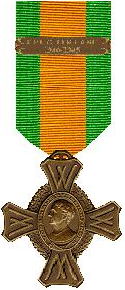| War Commemorative Cross | |
|---|---|
 Obverse of the War Commemorative Cross | |
| Type | Military campaign decoration |
| Awarded for | Service during the war in specified locations, time periods, or character of service. |
| Presented by | the Kingdom of the Netherlands |
| Campaign(s) | World War II |
| Status | No longer awarded |
| Established | 16 March 1944 |
| Undress Ribbon for one clasp Undress Ribbon for two clasps Undress Ribbon for three clasps Undress Ribbon for four clasps | |
| Precedence | |
| Next (higher) | Lombok Cross [1] |
| Next (lower) | Resistance Commemorative Cross [1] |
The War Commemorative Cross (Dutch : Oorlogsherinneringskruis) is a military award of the Netherlands. The medal was established to commemorate service to the Kingdom of the Netherlands during World War II. The medal was established on 16 March 1944 by royal decree of Queen Wilhelmina.